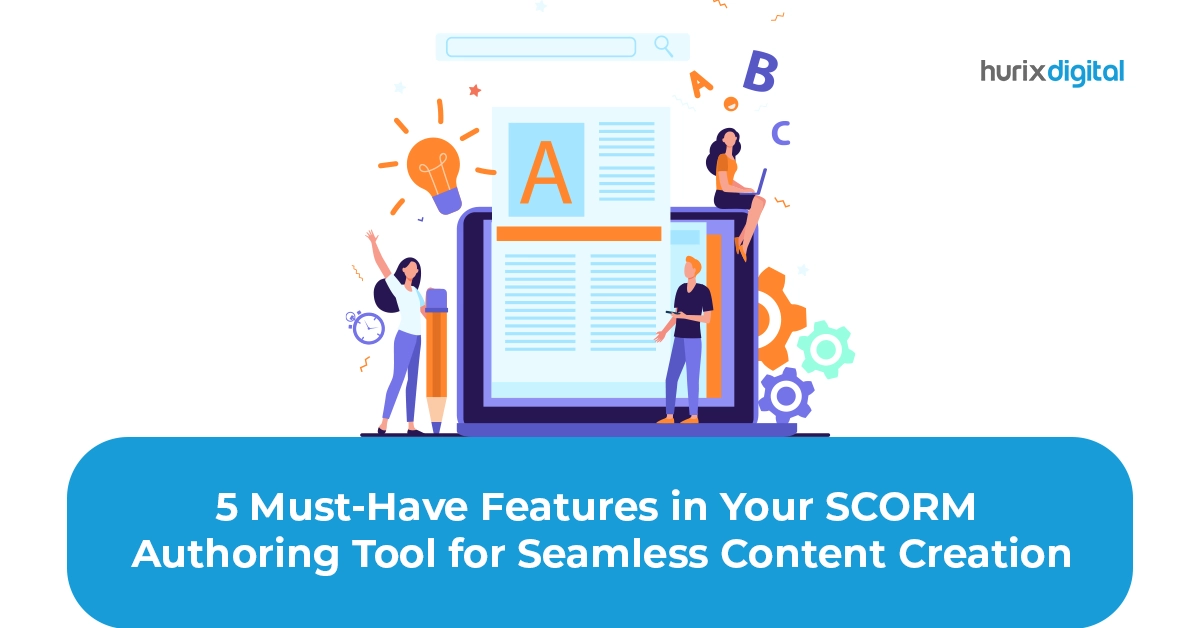
Top 8 Factors to Consider During eLearning Content Development
In the wake of the COVID pandemic, it has become evident that learning cannot be restricted to a classroom environment. Professionals need to grow and reach bigger milestones even if they are working remotely and adjusting to a new normal. This is the reason why many organizations have started using eLearning platforms, as it is one of the most effective and engaging mediums to teach and train employees. Such platforms have long been a training tool for the corporate sector because of their flexibility, scalability, and cost-effectiveness. In this blog, we will talk about the factors to be considered during eLearning content development.
Table of Contents:
- What to Consider While Developing Online Training Courses
- To 8 Factors to Consider During E-learning Content Development
1. Learning Objectives
2. Target Audience
3. Business Goals of the Course
4. Device Compatibility
5. Use of Interactivities And Real Life Scenarios
6. Self-paced Learning
7. Accessible Courses
8. Evaluation of the Course - Conclusion
What to Consider While Developing Online Training Courses. In order to create engaging, interactive, and learner-centric training modules for employees, you need to consider the following factors:
- Learning objectives
- Target audience
- Business goals of the training program
- Device compatibility
- Use of interactivities and real-life scenarios
- Self-paced learning
- Accessible courses
- Evaluation of the course
Top 8 Factors to Consider During E-learning Content Development
1. Learning Objectives
You must be aware of the objectives of the training program– what competency is to be acquired by the learners after taking the course. For example, is the course going to deliver compliance training to the employees or train them on some new upgradation in their ERP or software? Once the learning objectives are finalized, it’s easy to create relevant content.
2. Target Audience
It is essential to define the target audience well before developing an eLearning course as it will give you a clear picture of what to include in the course module and what to ignore. You need to analyze the learning content and the profiles of the people you are targeting.
The following elements need to be known about the target audience:
- Education Level – The education of employees does matter, for obvious reasons. A Graduate employee will have a completely different level of understanding as compared to an employee who has passed high school. So, you need to take into account the education level of different employees to make the course more learner-friendly.
- Age of Learners – A millennial might prefer simulations and gaming in learning, while Gen X and Gen Y learners might prefer text-based content. Hence, different learning styles will work for different age groups.
- Prior Experience with eLearning – Those who have prior experience with eLearning might not be as excited as those who are exploring eLearning for the first time. This should be considered while designing the course. You need to keep the training module interactive so as to keep all the learners equally engaged.
- Learner Preferences – Not all employees have the same taste for learning. Hence, it is important to include different content types like visual, kinesthetic, and audio. A right balance of all content types will make the course fresh and interesting.
Know More: Best Content Development Techniques for eLearning Courses
3. Business Goals of the Course
Knowing the business goals of the course beforehand will help you save time and cost. For example, if an organization wants to develop the selling skills of its sales workforce, it would be best to develop a course addressing that need.
4. Device Compatibility
All the features and interactivities of eLearning courses might not be compatible with all devices. So, before developing any course content, it is best to analyze device compatibility as some companies have the “BYOD” policy where employees bring their own devices to work. Making an eLearning module mobile compatible makes it more attractive for consumption, as the employees can access it whenever they want by the virtue of ubiquitous learning.
Know More: Choosing the Right eLearning Content Development Service Provider
5. Use of Interactivities And Real Life Scenarios
If an eLearning program has to be effective, it has to be engaging. Using various kinds of interactivities in eLearning content can help learners remain interested and engaged with the course, since it takes out the monotony of one-way communication.
Using real life scenarios with cognitive theories will help learners to associate new information with familiar situations or facts, and improve the quality of the knowledge they receive.
Know More: Top Tips to Design, Develop and Deliver e-Learning Content!
WHITEPAPER:
Maximizing the ROI & Business Impact of Enterprise Learning
6. Self-paced Learning
Self-paced learning is an approach that can accommodate different kinds of learners to define their personal learning paths and ensure that learning objectives are fulfilled and the learners do not feel overwhelmed at any point. Using this approach, you can make eLearning easy with the help of webinars, facilitators, voice chat, chats, video conferencing, asynchronous and on-line tutoring, etc.
These techniques establish important links between instructor-led training and eLearning, and provide learners the convenience of learning at their own pace – when and where needed, based on their individual needs and interests.
Know More: 9 Reasons Why Custom eLearning Solutions Are Better Than Off-the-Shelf Courses
7. Accessible Courses
Do consider employees with physical disabilities while developing courses for eLearning. For example, not using certain colors on the screen will help employees with color blindness. Such minor factors, when considered, will help in creating more accessible courses. Also, use simple language, break up the modules into short, bite-sized chunks, and make it accessible and easy to remember, anytime and anywhere.
8. Evaluation of the Course
It is not enough to create an eLearning course and be done with it. You need to evaluate the effectiveness of the course. It can be done with the help of quizzes, tests, and by gauging employee behavior or response. So, make sure that you have an evaluation and feedback mechanism ingrained in the core of your eLearning course content. You must have a well-designed and structured assessment plan to evaluate the outcomes of the learnings.
Conclusion
Content development for eLearning courses needs to be a thoughtful and strategic process. From identifying the target audience and understanding the learning objectives to using different content formats, making the course realistic and interactive, and accessible for all, a number of things must be kept in mind. You will also need to consider the device compatibility of the eLearning course, the ease and flexibility it offers to different kinds of learners, and assess the effectiveness of the course over time, to make it a complete success.

Senior Vice President – Business Development
Over 25 years of experience in the edtech and workforce learning industry with strong skills in Business Development, Customer Relationship Management (CRM) and Strategy.







